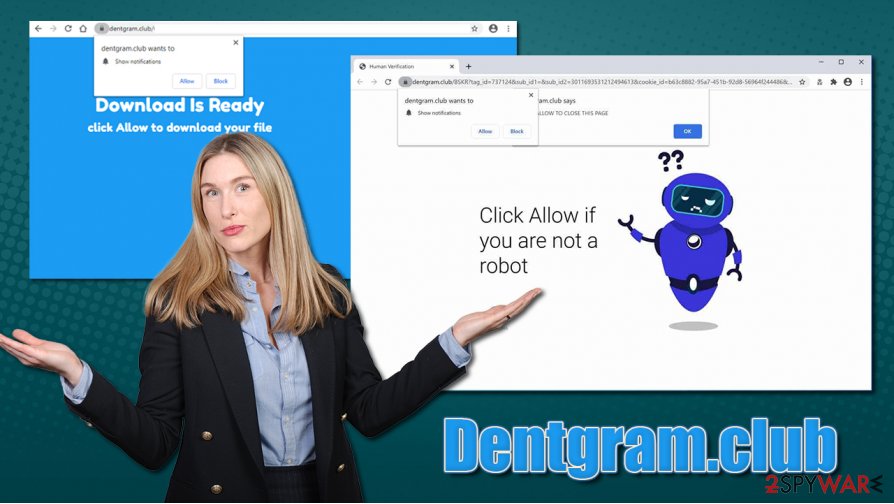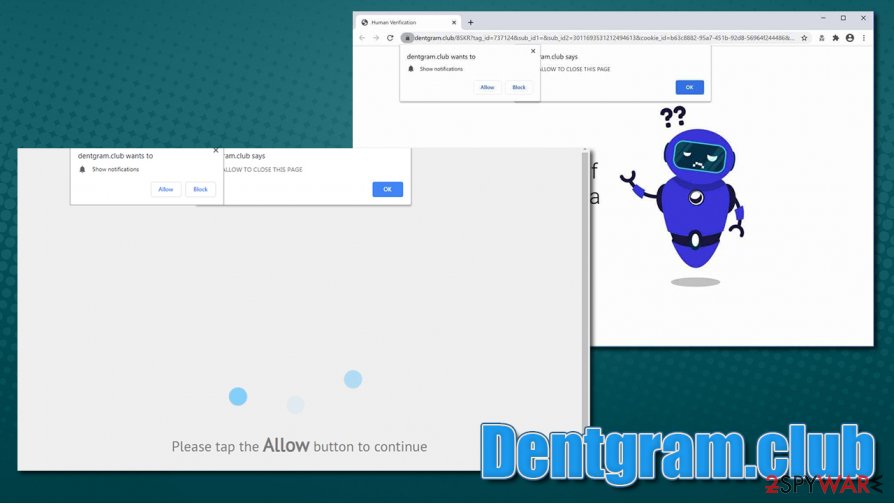Dentgram.club (Removal Guide) - Free Instructions
Dentgram.club Removal Guide
What is Dentgram.club?
Dentgram.club is a push notification virus that can be caused by adware

Dentgram.club is a suspicious website that you might encounter unexpectedly during your web browsing sessions on Google Chrome, Mozilla Firefox, Safari, or another web browser. As soon as you enter the site, you will be asked to allow notifications to be shown in order to bypass human checks, which ensure that you are not a bot,[1] or that some type of download is ready for you. However, it is just a scam compiled in a way that would allow third-parties to monetize on Dentgram.club ads that will be shown directly on your desktop, regardless if your browser is running or not.
Due to the sudden appearance of suspicious notifications, users might call the phenomenon Dentgram.club virus, although the term is not precisely correct. The unwanted ads that show up on your desktop can be eliminated by accessing your web browser settings, although, if you were a victim of this scam, it is also wise to check the computer for adware. Check the detailed Dentgram.club removal instructions below.
| Name | Dentgram.club |
| Type | Rogue website, although redirects to it might be caused by adware infection |
| Infiltration | After pressing the “Allow” button which allows showing notifications via the browser pop-up prompts; adware is most commonly installed along with other software from third-party websites (software bundling) |
| Symptoms | Intrusive desktop notifications show up on the desktop at any time, promoting websites of dubious content |
| Risks | Since the ads displayed by the website might be dangerous, users might suffer from financial losses, installation of malware/PUPs, or sensitive information disclosure to unknown parties |
| Elimination | To get rid of notifications, you should access the settings of your web browser how it is explained below |
| Additional steps | You should also check your system for adware ad eliminate it with security software or by using a manual guide. Experts[2] also recommend fixing virus damage with repair software (we recommend FortectIntego) and resetting web browser settings for best results |
Dentgram.club is one of many websites that abuses legitimate web browser notification features, which are often used by various websites in order to notify users who are interested in that site's content. Examples include Pushails.com, Stewaysef.info, Edundedpra.club, Streampro.club, and many others. While it might seem like these sites have nothing to do with each other, they all have a common goal – to mislead users.
Typically, Dentgram.club would show a message where the page content is located. Various themes are used by crooks although all of them include social engineering techniques, for example:
- Website promises to play a video which looks like one from YouTube;
- Website asks to confirm that the visitor is not a robot;
- Website inclines that +18 content will be shown as soon as “Allow” button is pressed;
- Website claims that a download is ready, although there is no mention of what type of download it is.
However, those who get tricked by crooks and press the allow button, they will see that the promised content is nowhere to be seen, and they are simply returned to the same page. Instead, visitors will start encountering Dentgram.club notifications that will be delivered directly to the desktop.

Since users get tricked into allowing desktop ads, they might not be aware that these prompts are coming from the browser. Hence, they would not know how to remove Dentgram.club notifications for good. Luckily, this can be easily reverted by accessing your web browser settings and declining the site to show notifications – we explain how to do that below.
However, you should also be aware that you might also be infected with adware or malware since redirects to suspicious sites such as Dentgram.club can be caused by computer viruses. To make sure that this is (not) the case, we suggest you perform a full system scan with anti-malware software or eliminate all the potentially unwanted programs manually.
If you find malware on your device, you should also perform additional checks with FortectIntego, as malicious software can permanently damage system files, which can result in serious stability issues and crashes.
Learn to avoid being tricked by deceptive websites
Online fraud is extremely widespread, with millions of computer users losing money to scams and suffering from malware infections. Since most of the planet is now using the internet, scams can be a very profitable business for cybercriminals, hence malicious websites are created on a daily basis on a massive scale. You should take adequate steps in order to protect your computer and your personal information from online dangers.
Common scam themes include:
- Push notification feature abuse. This feature is legitimate and was started being used in 2014 by Google Chrome. Soon after, other browsers adopted it. However, a push notification feature is often abused by scammers to trick users into subscribing to ads that would show up on their desktops. These ads are often of a malicious nature.
- Fake Flash Player notifications. Flash Player is an outdated and flawed plugin that should not be used. Nevertheless, scammers constantly use the prominent name of the previously widely-used software in order to make users believe that they need to install the alleged updates on their machines. Fake Flash updates remain one of the leading causes of adware and malware infections.[3]
- Fake virus infection claims. Users who never encountered an online scam before might easily fall for it. As soon as they enter a malicious website, they are told that their computer is infected and that their personal details are being stolen. Users are then asked to call alleged tech support or download malicious applications to remove the fake virus infection.
Thus, do not interact with malicious websites that push scams like the ones mentioned above and simply leave the page immediately. A powerful web protection application could also warn you about fraud, spoofing, and other malicious websites.

Delete Dentgram.club notifications and check your system for infections
While Dentgram.club notifications might not be related to any type of infection on your system (since you enabled it via the website), redirects to this and other malicious sites could be caused by an adware. The so-called ad-supported software is designed to show users intrusive ads in forms of popups, deals, offers, banners, coupons, and track their online activity in the background. Thus, Dentgram.club removal might not be the only thing that you have to take care of in order to keep your computer clutter-free. To get rid of unwanted apps, check the manual guide below. You can also scan the device wit powerful anti-malware software to eliminate malware automatically.
To remove Dentgram.club popups and notifications, you should follow these instructions:
Google Chrome
- Go to Menu > Settings
- Scroll down and select Advanced
- Under Privacy and security, click Site Settings > Notifications
- In the Allow section, look for Dentgram.club
- Click More Actions and then choose Block
Safari:
- Go to Safari > Preferences…
- Under Websites tab, pick Notifications
- Select Dentgram.club and then click Deny
Mozilla Firefox:
- Go to Menu > Options
- Choose Privacy & Security > Notifications
- Pick Settings – you should see Dentgram.club there
- Click on the the drop-down menu and select Block
- Save Changes
You may remove virus damage with a help of FortectIntego. SpyHunter 5Combo Cleaner and Malwarebytes are recommended to detect potentially unwanted programs and viruses with all their files and registry entries that are related to them.
Getting rid of Dentgram.club. Follow these steps
Uninstall from Windows
To get rid of potentially unwanted programs on Windows systems, follow these steps:
Instructions for Windows 10/8 machines:
- Enter Control Panel into Windows search box and hit Enter or click on the search result.
- Under Programs, select Uninstall a program.

- From the list, find the entry of the suspicious program.
- Right-click on the application and select Uninstall.
- If User Account Control shows up, click Yes.
- Wait till uninstallation process is complete and click OK.

If you are Windows 7/XP user, proceed with the following instructions:
- Click on Windows Start > Control Panel located on the right pane (if you are Windows XP user, click on Add/Remove Programs).
- In Control Panel, select Programs > Uninstall a program.

- Pick the unwanted application by clicking on it once.
- At the top, click Uninstall/Change.
- In the confirmation prompt, pick Yes.
- Click OK once the removal process is finished.
Delete from macOS
macOS users can also fall victim to adware. Terminate it with the help of these instructions:
Remove items from Applications folder:
- From the menu bar, select Go > Applications.
- In the Applications folder, look for all related entries.
- Click on the app and drag it to Trash (or right-click and pick Move to Trash)

To fully remove an unwanted app, you need to access Application Support, LaunchAgents, and LaunchDaemons folders and delete relevant files:
- Select Go > Go to Folder.
- Enter /Library/Application Support and click Go or press Enter.
- In the Application Support folder, look for any dubious entries and then delete them.
- Now enter /Library/LaunchAgents and /Library/LaunchDaemons folders the same way and terminate all the related .plist files.

Remove from Microsoft Edge
Delete unwanted extensions from MS Edge:
- Select Menu (three horizontal dots at the top-right of the browser window) and pick Extensions.
- From the list, pick the extension and click on the Gear icon.
- Click on Uninstall at the bottom.

Clear cookies and other browser data:
- Click on the Menu (three horizontal dots at the top-right of the browser window) and select Privacy & security.
- Under Clear browsing data, pick Choose what to clear.
- Select everything (apart from passwords, although you might want to include Media licenses as well, if applicable) and click on Clear.

Restore new tab and homepage settings:
- Click the menu icon and choose Settings.
- Then find On startup section.
- Click Disable if you found any suspicious domain.
Reset MS Edge if the above steps did not work:
- Press on Ctrl + Shift + Esc to open Task Manager.
- Click on More details arrow at the bottom of the window.
- Select Details tab.
- Now scroll down and locate every entry with Microsoft Edge name in it. Right-click on each of them and select End Task to stop MS Edge from running.

If this solution failed to help you, you need to use an advanced Edge reset method. Note that you need to backup your data before proceeding.
- Find the following folder on your computer: C:\\Users\\%username%\\AppData\\Local\\Packages\\Microsoft.MicrosoftEdge_8wekyb3d8bbwe.
- Press Ctrl + A on your keyboard to select all folders.
- Right-click on them and pick Delete

- Now right-click on the Start button and pick Windows PowerShell (Admin).
- When the new window opens, copy and paste the following command, and then press Enter:
Get-AppXPackage -AllUsers -Name Microsoft.MicrosoftEdge | Foreach {Add-AppxPackage -DisableDevelopmentMode -Register “$($_.InstallLocation)\\AppXManifest.xml” -Verbose

Instructions for Chromium-based Edge
Delete extensions from MS Edge (Chromium):
- Open Edge and click select Settings > Extensions.
- Delete unwanted extensions by clicking Remove.

Clear cache and site data:
- Click on Menu and go to Settings.
- Select Privacy, search and services.
- Under Clear browsing data, pick Choose what to clear.
- Under Time range, pick All time.
- Select Clear now.

Reset Chromium-based MS Edge:
- Click on Menu and select Settings.
- On the left side, pick Reset settings.
- Select Restore settings to their default values.
- Confirm with Reset.

Remove from Mozilla Firefox (FF)
Remove dangerous extensions:
- Open Mozilla Firefox browser and click on the Menu (three horizontal lines at the top-right of the window).
- Select Add-ons.
- In here, select unwanted plugin and click Remove.

Reset the homepage:
- Click three horizontal lines at the top right corner to open the menu.
- Choose Options.
- Under Home options, enter your preferred site that will open every time you newly open the Mozilla Firefox.
Clear cookies and site data:
- Click Menu and pick Settings.
- Go to Privacy & Security section.
- Scroll down to locate Cookies and Site Data.
- Click on Clear Data…
- Select Cookies and Site Data, as well as Cached Web Content and press Clear.

Reset Mozilla Firefox
If clearing the browser as explained above did not help, reset Mozilla Firefox:
- Open Mozilla Firefox browser and click the Menu.
- Go to Help and then choose Troubleshooting Information.

- Under Give Firefox a tune up section, click on Refresh Firefox…
- Once the pop-up shows up, confirm the action by pressing on Refresh Firefox.

Remove from Google Chrome
It is recommended to reset Google Chrome in order to get rid of adware traces and settings:
Delete malicious extensions from Google Chrome:
- Open Google Chrome, click on the Menu (three vertical dots at the top-right corner) and select More tools > Extensions.
- In the newly opened window, you will see all the installed extensions. Uninstall all the suspicious plugins that might be related to the unwanted program by clicking Remove.

Clear cache and web data from Chrome:
- Click on Menu and pick Settings.
- Under Privacy and security, select Clear browsing data.
- Select Browsing history, Cookies and other site data, as well as Cached images and files.
- Click Clear data.

Change your homepage:
- Click menu and choose Settings.
- Look for a suspicious site in the On startup section.
- Click on Open a specific or set of pages and click on three dots to find the Remove option.
Reset Google Chrome:
If the previous methods did not help you, reset Google Chrome to eliminate all the unwanted components:
- Click on Menu and select Settings.
- In the Settings, scroll down and click Advanced.
- Scroll down and locate Reset and clean up section.
- Now click Restore settings to their original defaults.
- Confirm with Reset settings.

Delete from Safari
Remove unwanted extensions from Safari:
- Click Safari > Preferences…
- In the new window, pick Extensions.
- Select the unwanted extension and select Uninstall.

Clear cookies and other website data from Safari:
- Click Safari > Clear History…
- From the drop-down menu under Clear, pick all history.
- Confirm with Clear History.

Reset Safari if the above-mentioned steps did not help you:
- Click Safari > Preferences…
- Go to Advanced tab.
- Tick the Show Develop menu in menu bar.
- From the menu bar, click Develop, and then select Empty Caches.

After uninstalling this potentially unwanted program (PUP) and fixing each of your web browsers, we recommend you to scan your PC system with a reputable anti-spyware. This will help you to get rid of Dentgram.club registry traces and will also identify related parasites or possible malware infections on your computer. For that you can use our top-rated malware remover: FortectIntego, SpyHunter 5Combo Cleaner or Malwarebytes.
How to prevent from getting viruses
Stream videos without limitations, no matter where you are
There are multiple parties that could find out almost anything about you by checking your online activity. While this is highly unlikely, advertisers and tech companies are constantly tracking you online. The first step to privacy should be a secure browser that focuses on tracker reduction to a minimum.
Even if you employ a secure browser, you will not be able to access websites that are restricted due to local government laws or other reasons. In other words, you may not be able to stream Disney+ or US-based Netflix in some countries. To bypass these restrictions, you can employ a powerful Private Internet Access VPN, which provides dedicated servers for torrenting and streaming, not slowing you down in the process.
Data backups are important – recover your lost files
Ransomware is one of the biggest threats to personal data. Once it is executed on a machine, it launches a sophisticated encryption algorithm that locks all your files, although it does not destroy them. The most common misconception is that anti-malware software can return files to their previous states. This is not true, however, and data remains locked after the malicious payload is deleted.
While regular data backups are the only secure method to recover your files after a ransomware attack, tools such as Data Recovery Pro can also be effective and restore at least some of your lost data.
- ^ What Is a Spam Bot? | How Spam Comments and Spam Messages Spread. Cloudflare. The Web Performance & Security Company.
- ^ Lesvirus. Lesvirus. Cybersecurity advice and malware insights.
- ^ Joshua Long. Adobe Flash Player is dead, yet 10% of Macs are infected with fake Flash malware. Intego. The Mac Security Blog.























